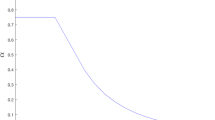Abstract
This paper analyzes optimal pricing for access to essential facilities in a competitive environment. The focus is on investment incentive issues arising from regulation under complete information. To that end, examining the provision of a natural monopoly infrastructure with unlimited capacity, it is shown that the fixed component of a regulated access price can be structured so as to induce a “race” between market participants to provide the infrastructure. An appropriate pricing formula can ensure that a single firm chooses to invest at the socially optimal time (taking into account producer and consumer surplus) despite the immediate access granted to rivals and the non-existence of government subsidies. Under the optimal pricing formula, firms choose their investment timing based on their desire to pre-empt their rivals. This pricing formula is efficient (a two part tariff), implementable ex post, and robust to alternative methods of asset valuation (replacement or historical cost). When firms are not identical, the access pricing formula resembles, in equilibrium, a fully distributed cost methodology.
Similar content being viewed by others
References
Armstrong, M., S. Cowan, and J. Vickers. 1994. Regulatory Reform: Economic Analysis and British Experience. Cambridge, MA: MIT Press.
Armstrong, M., C. Doyle, and J. Vickers. 1996. “The Access Pricing Problem: A Synthesis.” Journal of Industrial Economics 44(2): 131–150.
Baumol, W. J., M. F. Koehn, and R. D. Willig. 1987. “How Arbitrary is ‘Arbitrary’? or, Toward the Deserved Demise of Full Cost Allocation.” Public Utilities Fortnightly 120(5): 16.
Baumol, W. J., and J. G. Sidak. 1994. Toward Competition in Local Telephony. Cambridge, MA: MIT Press.
Dasgupta, P., and J. E. Stiglitz. 1980. “Uncertainty, Industrial Structure, and the Speed of R&D.” Bell Journal of Economics 11(1): 1–28.
de Fontenay, C., and J. S. Gans. 2000. Extending Market Power Through Vertical Integration. Working Paper Melbourne Business School (www.mbs.unimelb.edu.au/jgans/research.htm)
Demsetz, H. 1968. “Why Regulate Utilities?” Journal of Law and Economics 11(1): 55–66.
Fudenberg, D., and J. Tirole. 1985. “Preemption and Rent Equalization in the Adoption of New Technology.” Review of Economic Studies 52(2): 383–401.
Gans, J. S., and S. Stern. 2000. “Incumbency and R&D Incentives: Licensing the Gale of Creative Destruction.” Journal of Economics and Management Strategy 9(4): 485–511.
Gans, J. S., and P. L. Williams. 1999. “Access Regulation and the Timing of Infrastructure Investment.” Economic Record 79(229): 127–138.
Hart, O., and J. Tirole. 1990. “Vertical Integration and Market Foreclosure.” Brookings Papers on Economic Activity (Microeconomics) 205–286.
Hausman, J. A. 1997. “Valuing the Effect of Regulation on New Services in Telecommunications.” Brookings Papers on Economic Activity (Microeconomics) 1–38.
Katz, M. L., and C. Shapiro 1987. “R&D Rivalry with Licensing or Imitation.” American Economic Review 77(3): 402–420.
King, S. P. 1996. “Asset Valuation and Access to Essential Facilities Under Part IIIA of the Trade Practices Act 1974 (Cth).” In Deregulation of Public Utilities: Current Issues and Perspectives, edited by M. Richardson Melbourne: Center for Corporate Law and Securities Regulation, 94–116.
King, S. P., and R. Maddock. 1996. Unlocking the Infrastructure. Sydney: Allen & Unwin.
King, S. P., and R. Maddock. 1999. “Light-handed Regulation of Access in Australia: Negotiation with Arbitration.” Information Economics and Policy 11(1): 1–22.
Laffont, J.-J., and J. Tirole. 1993. A Theory of Incentives in Procurement and Regulation. Cambridge, MA: MIT Press.
Laffont, J.-J., and J. Tirole. 1994. “Access Pricing and Competition.” European Economic Review 38(4): 1673–1710.
Laffont, J.-J., and J. Tirole. 1999. Competition in Telecommunications. Cambridge, MA: MIT Press.
Mandy, D. M. 2000. “Killing the Goose That May Have Laid the Golden Egg: Only the Data Knows Whether Sabotage Pays.” Journal of Regulatory Economics. 17(2): 157–172.
Reinganum, J. F. 1989. “On the Timing of Innovation.” In Handbook of Industrial Organization, Volume 1, edited by R. Schmalansee and R. Willig. Amsterdam: Elsevier.
Rey, P., and J. Tirole. 1996. “A Primer on Foreclosure.” In Handbook of Industrial Organization, Volume 3, edited by R. Schmalansee and R. Willig. Amsterdam: Elsevier (forthcoming).
Riordan, M. H. 1992. “Regulation and Preemptive Technology Adoption.” RAND Journal of Economics 23(3): 334–349.
Tirole, J. 1988. The Theory of Industrial Organization. Cambridge, MA: MIT Press.
Vickers, J. 1995. “Competition and Regulation in Vertically Related Markets.” Review of Economic Studies 62(1): 1–18.
Von Hippel, E. 1988. The Sources of Innovation. Oxford: Oxford University Press.
Author information
Authors and Affiliations
Rights and permissions
About this article
Cite this article
Gans, J.S. Regulating Private Infrastructure Investment: Optimal Pricing for Access to Essential Facilities. Journal of Regulatory Economics 20, 167–189 (2001). https://doi.org/10.1023/A:1011155312792
Issue Date:
DOI: https://doi.org/10.1023/A:1011155312792




